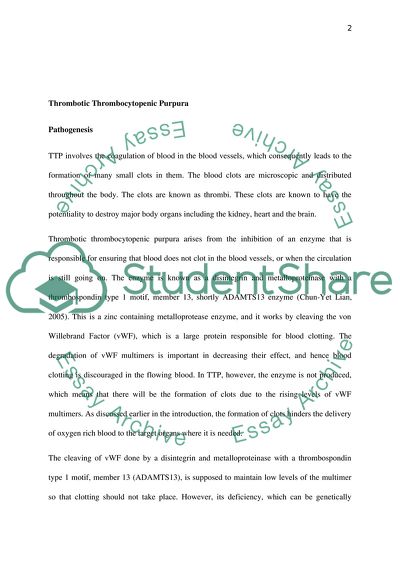Cite this document
(“Haematology: Thrombotic Thrombocytopenic Purpura (TTP) Essay”, n.d.)
Haematology: Thrombotic Thrombocytopenic Purpura (TTP) Essay. Retrieved from https://studentshare.org/health-sciences-medicine/1832600-haematology-essaysubject-area-haemostasis-can-thrombotic-thrombocytopenic-purpura-ttp-be-described-as-both-a-clotting-disorder-and-a-bleeding-disorder-please-discuss
Haematology: Thrombotic Thrombocytopenic Purpura (TTP) Essay. Retrieved from https://studentshare.org/health-sciences-medicine/1832600-haematology-essaysubject-area-haemostasis-can-thrombotic-thrombocytopenic-purpura-ttp-be-described-as-both-a-clotting-disorder-and-a-bleeding-disorder-please-discuss
(Haematology: Thrombotic Thrombocytopenic Purpura (TTP) Essay)
Haematology: Thrombotic Thrombocytopenic Purpura (TTP) Essay. https://studentshare.org/health-sciences-medicine/1832600-haematology-essaysubject-area-haemostasis-can-thrombotic-thrombocytopenic-purpura-ttp-be-described-as-both-a-clotting-disorder-and-a-bleeding-disorder-please-discuss.
Haematology: Thrombotic Thrombocytopenic Purpura (TTP) Essay. https://studentshare.org/health-sciences-medicine/1832600-haematology-essaysubject-area-haemostasis-can-thrombotic-thrombocytopenic-purpura-ttp-be-described-as-both-a-clotting-disorder-and-a-bleeding-disorder-please-discuss.
“Haematology: Thrombotic Thrombocytopenic Purpura (TTP) Essay”, n.d. https://studentshare.org/health-sciences-medicine/1832600-haematology-essaysubject-area-haemostasis-can-thrombotic-thrombocytopenic-purpura-ttp-be-described-as-both-a-clotting-disorder-and-a-bleeding-disorder-please-discuss.


